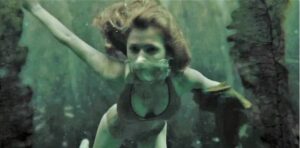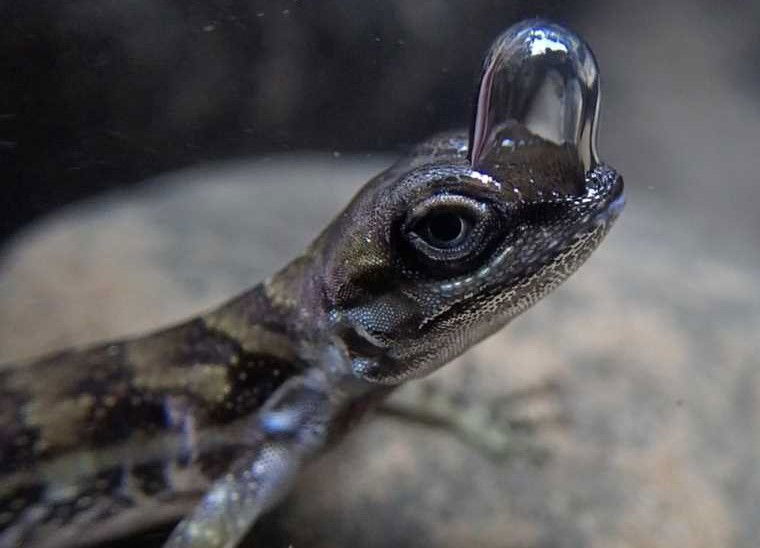Researchers from Binghamton University, State University of New York have determined that a semi-aquatic species of scuba diving lizard can produce an air bubble on its head so it can breathe underwater, much like the Bubble Head Charm used by Fleur Delacour in Harry Potter and the Goblet of Fire.
Previous research had spotted the self-made bubble, but this is the first study to determine that these lizards, also called water anoles, use it to help them breathe underwater while evading its numerous predators.
“We didn’t know whether there was actually any functional role for this bubble in respiration,” explained Lindsey Swerk, an assistant research professor of biological sciences at Binghamton University and the scientist who first documented the animal’s use of an air bubble. “Is it something that lizards do that is just a side effect of their skin’s properties or a respiratory reflex, or is this bubble truly allowing them to stay underwater longer than they would, say, without a bubble?”


Scuba Diving Lizard Can Stay Underwater for 20 Minutes
According to the researchers, these lizards can create bubbles due to their highly water-repellent skin. So, to determine if the air bubble was helping the animal stay underwater longer, Swierk and colleagues applied a substance to the skin of these semi-aquatic lizards that prevented bubble formation.
“Lizard skin is hydrophobic,” said Swierk. “Typically, that allows air to stick very tightly to the skin and permits this bubble to form. But when you cover the skin with an emollient, air no longer sticks to the skin surface, so the bubbles can’t form.”
Following the application of the emollient, the researchers measured the number and duration of bubbles each scuba diving lizard produced. This data was compared against a control group of lizards that were allowed to breathe normally. That comparison showed that the lizards who could breathe normally were able to stay underwater 32% longer than the bubble-challenged lizards.
Swierk says this result shows that the bubble is not a byproduct of normal respiration. Instead, the bubble is an evolutionary mechanism specifically adapted to allow these prey animals to breathe underwater while avoiding predators.
“Before, we suspected it – we saw a pattern – but we didn’t actually test if it served a functional role,” said Swierk. “We know that they can stay underwater for a really long time. We also know that they’re pulling oxygen from this bubble of air.”
This evolutionary advantage is particularly useful to this Costa Rica tropical forest dweller, as semi-aquatic lizards serve as a food source for a wide range of predators.
“Anoles are kind of like the chicken nuggets of the forest. Birds eat them, snakes eat them,” said Swiek. “So by jumping in the water, they can escape a lot of their predators, and they remain very still underwater.”
The researcher notes that this particular anole is “pretty well camouflaged underwater,” so the bubble provides enough added protection for it to stay hidden deep underwater until the danger passes. Also, although the length of time measured by the study authors varied from lizard to lizard, they say this species of scuba diving lizard can stay underwater longer than any human.
“We know that they can stay underwater at least about 20 minutes, but probably longer,” Swierk said.
Further Study Will Determine if the Bubble Functions as a Physical Gill
Following the success of this study, Swierk and colleagues say they want to determine if the air bubble produced by their scuba diving lizard is functioning like a physical gill. Unlike lungs, physical gills allow insects to breathe underwater by collecting the oxygen that diffuses from the water into the air bubble.
Alexandra Martin, one of Swierk’s graduate students, will conduct those experiments, which will involve changing the oxygenation levels in the water to see if it increases or decreases the average dive time of the scuba diving lizard. Still, Swierk says it is unlikely, as insects require much less oxygen than lizards, but even ruling it out would be helpful.
Finally, while the researchers believe their study could offer some practical applications, they say it is also a compelling story that can help foster interest in the power of science.
“I’ve had people talk to me about how much they love scuba diving and freediving and how they’re interested in how animals might do the same thing,” said Swierk. “So there’s a great opportunity to get people excited about science by having this relationship between what they love to do and what’s evolved in nature.”
“Even in animals that seem commonplace – you’re always finding new things,” Swierk added.
The paper, “Novel rebreathing adaptation extends dive time in a semi-aquatic lizard,” was published in Biology Letters.
Christopher Plain is a Science Fiction and Fantasy novelist and Head Science Writer at The Debrief. Follow and connect with him on X, learn about his books at plainfiction.com, or email him directly at christopher@thedebrief.org.

